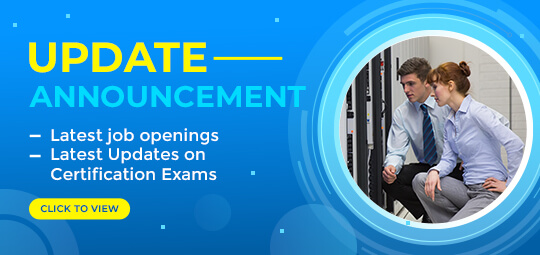TRUSTED BY THE SMARTEST TEAMS IN THE WORLD FOR CERTIFIED CANDIDATES
SPOTO Blogs
Useful learning materials to become certified IT personnel
-
- 852
- SPOTO
- 2025-04-17 17:16
-
- 1257
- circle
- 2025-04-09 16:31
-
- 1031
- circle
- 2025-04-09 15:46
-
- 2335
- SPOTO
- 2025-04-08 15:00
-
- 973
- circle
- 2025-04-08 11:27
-
- 1003
- circle
- 2025-04-08 10:56
-
- 1496
- circle
- 2025-04-07 11:48
-
- 1227
- circle
- 2025-04-07 11:21
-
- 1213
- circle
- 2025-04-03 11:49
TRUSTED BY THE SMARTEST TEAMS IN THE WORLD FOR CERTIFIED CANDIDATES
SPOTO Blogs
Useful learning materials to become certified IT personnel
-
- 852
- SPOTO
- 2025-04-17 17:16
Table of Contents1.What Is a collaboration administrator ?2.How To Become a collaboration administrator ?3.The Details3.Certify with us to start down your ideal career path As hybrid work becomes the norm, organizations increasingly rely on professionals who can manage and secure collaboration platforms like Microsoft Teams and Cisco Webex. While general IT roles may decline slightly, demand for skilled Collaboration Administrators remains steady—especially those certified in CCNP Collaboration or equivalent. Their expertise is essential for ensuring seamless, secure communication across modern workplaces. This article offers a professional and authoritative look at what a Collaboration Administrator is, how to pursue this career path, and practical steps you can take to get there. 1.What Is a collaboration administrator ? Meet the Collaboration Administrator -- the tech expert driving seamless communication, efficient user management, and actionable system insights. They play a crucial role in building and maintaining communication platforms that keep organizations connected and productive. Key Responsibilities of a Collaboration Administrator: Install, maintain, upgrade, and troubleshoot voice, video, and other collaboration technologies to ensure system stability and reliability. Manage company data models, user accounts, roles, and system services to ensure secure and efficient operations. Define and configure system clusters to optimize scalability and performance. Continuously monitor system performance to proactively identify and resolve potential issues. By overseeing platforms such as Microsoft Teams, Zoom, and other enterprise collaboration tools, Collaboration Administrators help ensure seamless communication, support efficient administration, deliver rich business insights, and enable powerful troubleshooting capabilities. 2.How To Become a collaboration administrator ? If you want to become a Collaboration Administrator and gain the necessary skills for the job, consider pursuing the CCNP Collaboration certification. This advanced training and certification will validate your expertise in implementing core collaboration technologies. Specifically, you will learn how to: Design, configure, and troubleshoot Cisco collaboration solutions. Securely set up, troubleshoot, and manage SIP phones. Integrate cloud-based phone systems with on-premises equipment. Understand how Cisco Unified Communications Manager (UCM) processes phone numbers. 3.The Details Salary of collaboration administrator The salary for a Collaboration Administrator can vary significantly based on factors like experience, location, and the specific company. However, a common range for a Senior Collaboration Administrator in the US is between $70,000 and $215,000 annually. Please see the table below for the average annual salary of each country Country USA U.K. Canada Singapore Australia Annual salary $72,966 £24,953 CA$53,983 SGD$4,747 $94,500 Collaboration administrator Job Outlook The job outlook for Collaboration Administrators—often categorized under Network and Computer Systems Administrators by the U.S. Bureau of Labor Statistics (BLS)—is projected to experience a slight decline over the next decade.The BLS expects network administrator positions to decline by 3 percent from 2023 to 2033.Despite the projected decline, there will be approximately 16,400 job openings each year. In summary, while the traditional role of Collaboration Administrators may see a modest decline, adapting to technological advancements and acquiring specialized skills can open new avenues in the IT landscape. Job Titles Related to collaboration administrator Computer Systems Administrators Collaboration solutions engineer Collaboration solutions architect Administrative Assistant Office Manager Operations Coordinator 3.Certify with us to start down your ideal career path CCNP Collaboration is a globally recognized standard for advanced networking certifications and professional validation. When you choose CCNP training, you're investing in a credential trusted by employers across industries worldwide. This certification not only builds your technical expertise, but also positions you for success in job interviews and career advancement. In other words, CCNP isn't just a certification — it's your strategic partner on the path to landing your next big role in IT. The training and certification for CCNP Collaboration provide all you need to know about implementing and operating collaboration solutions including infrastructure and design, protocols, codecs, endpoints, and more. What You'll Get with CCNP Collaboration Training: Guided learning:Follow guided Learning Paths created by Cisco pros that teach you exactly what you need to know to pass your exam. Pre- and post-assessments:Take pre- and post- assessments to gauge what you know, and decide what you still need to study. Hands-on labs:Practice your skills with real Cisco products so you’ll know your way around the tech you’ll be using in your job every day. Practice tests:Jumpstart your progress towards certification success by checking your exam readiness. Practice answering questions before it counts. -
- 1257
- circle
- 2025-04-09 16:31
The Microsoft Certified: Azure Administrator Associate (AZ-104) certification stands out as one of the top cloud credentials for IT professionals aiming to demonstrate real-world Azure skills. Whether you're a systems administrator, a network engineer exploring cloud technologies, or someone pivoting into cloud computing, this certification offers a strong foundation. So, how do you prepare for and pass AZ-104 with confidence? Here's a fresh, strategic approach—broken down into eight essential steps. Step 1: Grasp the Scope of the Certification AZ-104 focuses on the real-life responsibilities of an Azure administrator. The exam checks your ability to manage and maintain various services and resources on Azure. Specifically, it covers areas such as: Manage Azure identities and governance Implement and manage storage Deploy and manage Azure compute resources Implement and manage virtual networking Monitor and maintain Azure resources Instead of memorizing each point, aim to understand how these services interact in daily operations. Review Microsoft's official exam guide—it's your syllabus. Step 2: Build a Foundation Before Diving Deep Even though Microsoft doesn't mandate prerequisites, experience is vital. Ideally, you should have about six months of hands-on experience using Azure. If you're completely new, consider starting with the AZ-900: Azure Fundamentals to get a basic overview. Also, brushing up on networking basics, virtualization principles, and identity management will go a long way. Step 3: Curate High-Quality Learning Resources Don't just rely on one type of content. Mix and match formats to suit your learning style: Microsoft Learn: This is free, modular, and designed by Microsoft experts. It's an ideal place to start. Online Courses: Choose reputable instructors on platforms like Udemy, Coursera, or LinkedIn Learning. Look for those with high ratings and frequent updates. Practice Tests: Use them regularly to gauge your knowledge and get comfortable with the question format Video Tutorials and Webinars: These are especially helpful for visual learners and those who enjoy structured walkthroughs. Flashcards and Cheat Sheets: Use these for quick reviews and memorization of commands, services, and terminology. Step 4: Practice What You Learn with a Lab Setup Azure isn't theoretical. The exam expects you to know how things work in practice. To that end, build your own sandbox. Start by creating a free Azure account—Microsoft offers starter credits. Use these to deploy virtual machines, experiment with Azure AD roles, simulate network configurations, and automate tasks with PowerShell or the Azure CLI. Try challenges like: Configuring NSGs and VNets Deploying resources via templates Setting up monitoring tools and configuring alerts This kind of experimentation is the fastest way to deepen your understanding. Step 5: Plan Your Study Schedule Without a roadmap, it's easy to drift. Break the material into segments and assign them to weekly or bi-weekly goals. Use calendars or apps like Notion or Trello to keep track of progress. Step 6: Prioritize Conceptual Clarity Over Memorization Some topics are trickier than others and require deeper understanding: Networking: Azure routing, load balancing, peering, and NSGs can be complex. Storage: Understand the difference between LRS, GRS, and other redundancy models. Monitoring: Familiarize yourself with Log Analytics, Azure Monitor, and setting up custom alerts. Instead of rote learning, tie concepts to use cases or tasks you've performed in the lab. This not only makes it easier to recall but also helps you reason through questions. Step 7: Simulate the Real Exam with Practice Tests Practice exams aren't just a final step—they're an essential part of your preparation. Use them regularly to measure progress and adjust your study plan. When reviewing test results: Identify weak areas and revisit those topics Understand why each answer is right or wrong Note the question formats Microsoft tends to use Target a consistent score of 80% or higher before attempting the real deal. Step 8: Book the Exam and Tackle It with Confidence Once you're consistently performing well on practice exams and have covered all topics, schedule the real test through Pearson VUE. You can opt for an in-person exam center or take it remotely from home. Before exam day: Ensure your computer and environment meet Microsoft's testing requirements (for online exams) Have your government-issued ID ready Rest well the night before During the exam: Manage your time more wisely—don't spend much time on one question Use marks to revisit tricky ones later Trust your preparation and avoid second-guessing unless you're sure Wrapping Up Passing the AZ-104 certification is a solid achievement that proves you can manage Azure environments at a professional level. It boosts your credibility, opens career doors, and sets you up for more advanced certifications. The key is consistency, practical exposure, and understanding, not memorization. By following these eight steps with focus and discipline, you'll be well on your way to joining the ranks of Microsoft-certified professionals. Stay motivated, be hands-on, and approach the journey with curiosity. You've got everything it takes to succeed. -
- 1031
- circle
- 2025-04-09 15:46
The Cisco Certified Network Professional (CCNP) certification is a well-regarded milestone for networking professionals seeking to advance their skills and open up new career opportunities. Whether you're targeting the CCNP Enterprise, Security, Collaboration, Data Center, or Service Provider track, one thing is clear: preparation is key. With its mix of core technologies and a specialized concentration exam, CCNP is not a certification to take lightly. So, how do you study effectively for the CCNP exam and give yourself the best shot at passing on the first try? Here's a comprehensive guide to help you craft a smart and successful study plan. Know What You're Up Against The CCNP certification consists of two exams: A core exam covering foundational concepts. A concentration exam based on a specific area of expertise (e.g., advanced routing, network design, SD-WAN, etc.). Start by reviewing the exam blueprint on Cisco's official website. Understanding what each exam covers will help you avoid studying off-track. Print out the objectives and check them off as you go—this visual progress tracker can boost motivation and keep you organized. Step 1: Choose the Right Track and Specialization Before anything else, select the CCNP track that aligns with your career goals. Are you aiming for a career in enterprise networking, security, or cloud environments? Your concentration exam should reflect your long-term interests and the type of work you enjoy or plan to pursue. Step 2: Build a Study Timeline Set realistic goals and deadlines. Break your study plan into phases: Phase 1: Understand core concepts. Phase 2: Dive into the specialization topics. Phase 3: Review, practice labs, and take mock exams. Consistency is crucial. Even 1–2 hours a day of focused study is better than sporadic cram sessions. Step 3: Invest in Quality Study Resources Here's what you'll need: Cisco Press books: These are the gold standard for CCNP preparation. Official Cisco Learning Network resources: Use their study plans, discussion forums, and videos. Practice exams: Use them to test your readiness and get used to the exam format. Flashcards: For quick memory boosts, especially for commands and protocols. Step 4: Lab, Lab, Lab One of the best ways to master CCNP topics is through hands-on practice. Set up your own lab using physical gear or virtual tools like Cisco Packet Tracer, GNS3, or EVE-NG. Focus on: Configuring and troubleshooting routing protocols (EIGRP, OSPF, BGP) VLANs, STP, EtherChannel NAT, ACLs, VPNs QoS and automation (especially for newer exams) Lab work not only reinforces theoretical knowledge but also boosts your confidence for the real exam. Step 5: Master Exam Strategy CCNP exams are not just about knowing the material—they're about applying it. Expect scenario-based questions, simulations, and drag-and-drop formats. Read each question carefully before answering. Flag tough questions and come back to them. Manage your time—don't get stuck on a single problem. Practice with time-bound mock exams to build your mental stamina and reduce test-day anxiety. Step 6: Join Study Groups and Online Communities Don't study in isolation. Join CCNP study groups on Reddit, Discord, or Facebook. Engage in discussions, ask questions, and learn from others' experiences. Sometimes, a different explanation from a peer can make a complex topic click instantly. Step 7: Revise and Review Smartly In the final weeks before the exam: Focus on weak areas rather than reviewing everything. Skim over concepts you've mastered to keep them fresh. Do daily quizzes and quick labs to stay sharp. Use study sheets and mind maps to condense large topics. Final Thoughts The CCNP certification is a serious investment of time and effort, but it's also a powerful asset that can transform your career. By approaching your study with structure, using high-quality resources, and committing to consistent practice, you can set yourself up for exam-day success. Remember: passing the CCNP isn't just about getting a credential—it's about proving to yourself and others that you truly understand the complex networks that power our digital world. Study smart, stay motivated, and you'll earn it with confidence. -
- 2335
- SPOTO
- 2025-04-08 15:00
Table of ContentsNew! Cisco Wireless CertificationsLatest News: Huawei Certification OnVUE online proctoring service will no longer be availableLatest News: Cisco Certification Updates – "A New Era for Cisco Certifications"Latest News: Fortinet Certification Updates – NSE Program (Effective October 15, 2025)Latest News: Job OpeningsLatest News: PMBOK 8th Edition reviewTips: If you want to get certified fast, ping me for more details!IMPORTANT UPDATE: CompTIA A+ Exam ChangesIMPORTANT UPDATE: PMP Exam Fee Changes New! Cisco Wireless Certifications Cisco is introducing a new wireless certification track, reestablishing a dedicated focus on modern wireless technologies. The track includes Professional and Expert-level certifications that build practical skills to design, deploy, and manage advanced wireless networks. The new CCNP Wireless exams realign wireless content previously found in CCNP Enterprise, while the CCIE Wireless practical exam now incorporates Cisco Meraki along with Wi-Fi 6 and Wi-Fi 7. On March 19, 2026, Cisco will launch a Wireless certification track, the CCNP Wireless certification, and the CCIE Wireless certification. Key updates taking effect March 19, 2026: Wireless topics currently covered in the CCNP Enterprise Core (ENCOR) exam will be incorporated into a new exam: Implementing and Operating Cisco Wireless Core Technologies (350-101 WLCOR) v1.0. The following CCNP Enterprise exams will be realigned and renamed to the CCNP Wireless certification: CCNP Enterprise Last date to test March 18, 2026 CCNP Wireless Effective March 19, 2026 Designing Cisco Enterprise Wireless Networks v1.1 (ENWLSD 300-425) Designing Cisco Wireless Networks v1.2 (WLSD 300-110) Implementing Cisco Enterprise Wireless Networks v1.1 (ENWLSI 300-430) Implementing Cisco Wireless Advanced Solutions v1.2 (WLSI 300-120) Candidates that have passed 300-425 ENWLSD and 300-430 ENWLSI exams within the past 3 years, can choose to take the new 350-101 WLCOR exam to achieve CCNP Wireless certification Latest News: Huawei Certification OnVUE online proctoring service will no longer be available Starting from September 16 (Beijing Time), the Huawei Certification OnVUE online proctoring service will no longer be available to overseas individual candidates. Overseas TO B customers and partners who need to take the OnVUE online exam must have their local representative/regional contact organize and apply on their behalf. Huawei will continue to offer VUE on-site exam services. All candidates can book VUE on-site exams through the original booking channels. Latest News: Cisco Certification Updates – "A New Era for Cisco Certifications" Cisco is refreshing its certification framework to emphasize automation, software application design, and development skills. Specifically: Three revamped certification tracks have been introduced, targeting core competencies in network automation, application design, and software development. These appear to focus on aligning traditional networking credentials—like CCNA, and CCNP tracks—with modern, software-centric demands. Among these updates is the evolution of DevNet, which suggests a strong shift toward developer-focused skills across Cisco's certifications. Changes will take effect on February 3 (year unspecified in the summary, but presumably aligned with Cisco's roadmap updates). Although Cisco's summary doesn't list each updated certification by name, it's clear that: DevNet certifications are being elevated. CCNA and CCNP (e.g., Enterprise, Collaboration, Cybersecurity) tracks are being restructured to integrate more automation and development-related content. For more details, visit: Cisco: A New Era for Cisco Certifications Latest News: Fortinet Certification Updates – NSE Program (Effective October 15, 2025) Fortinet is rolling out substantial enhancements to its NSE (Network Security Expert) Certification Program: Reintroducing NSE Levels 1–8 as formal progress-based tracks. Adjusting certification tracks, which likely reflects the retirement of some offerings and a restructured curriculum flow. Retirement of the FCSS Zero Trust Access certification on June 30, 2025. The content has been redistributed into other FCSS paths, and current certifications remain valid until they expire. For those focused on ZTNA with FortiGate only, the recommended path is: FCP in Network Security → FCSS in Network Security For those combining ZTNA with FortiGate and FortiSASE, the path becomes: FCP in Network Security → FCSS in Secure Access Service Edge Latest News: Job Openings 崗位1:IT維運職位 詳情 負責超市門市建置專案IT基礎設施相關工作(包括不限於網路方案建置, 設備調試, 無線調配等)落地實施; 負責超市門市PC設備的系統安裝,軟體安裝,相關問題的排除; 負責超市門市POS,生鮮秤,掃描槍,PDA,電子價簽等職能終端設備的安裝、配置、問題排錯; 負責超市門市IT機房設備(防火牆,交換機,伺服器等)的日常管理與維護; 負責日常監控門市接取網絡,區域網絡,WIFI網路運作狀態(透過zabbix, ELK日誌系統等工具),快速解決相關網路問題; 協助超市門市智慧業務系統(電子秤, 電子價簽等管理系統)的部署、管理、維護工作; 協助業務處理其他IT相關問題,助理業務的穩定營運與發展 要求 本科以上學歷,熟悉辦公室或連鎖店網路基礎建設,有獨立IT專案建設經驗優先: 熟悉市面主流網路設備(如華為,H3C,銳捷等)交換器、防火牆、無線等網路系統概念及配置,具備網路故障分析排障能力; 精通Windows桌面作業系統及常用辦公室軟體; 有線下零售IT維運經驗者優先: 熟悉新零售業態的各種智慧終端如POS,電子價簽,電子秤等設備的使用與維護; 熟悉 linux centos系統, 會部署常見應用程式, 如kvm, ngix服務等, 有雲端操作經驗或維運自動化開發經驗優先; 具備鑽研精神及獨立解決問題的能力,較好的溝通總結能力,能接受在新零售業發展;有較強抗壓能力, 良好的服務意識; 可接受國內短期出差 地點在京津冀 京東職缺 目前招聘職缺是P5 具體薪資自己談,市面P5薪資基本15K左右 崗位2:ICT SE售前經理(P3A-P4A) 崗位職責: 工作地點:香港 負責客戶需求溝通,技術交流,方案設計,配置澄清與報價等售前支援工作。 組織策劃並負責公司產品的區域訓戰、行銷支援、話術賦能等產品拓展工作; 具備較強的ICT能力,能夠獨自設計產業性綜合方案(網絡,安全,虛擬化,雲端);有較強的技術實施能力,能夠對產業常規產品可以直接上手配置。 了解產業動態及產業發展方向,具備市場資訊收集及競爭對手狀況分析。 任職資格 教育背景:全日製本科及以上學歷,電腦科學、資訊科技、工程管理或相關專業。 工作經驗:至少3-5年ICT專案經驗,有成功落地複雜ICT專案的經驗者佳。 技能要求: 專業資質,擁有CCIE,HCIE,CISSP,等優先。 精通網路技術、儲存技術、精通雲端、大數據、通訊、安全、物聯網應用等某一領域相關技術 具有良好的團隊意識,執行力強,抗壓性強。能適應多項目同時處理的工作要求 良好的成本和預算管理知識,能夠進行專案成本估算和控制,具有出色的成本意識和風險意識。 國語,英語,粵語流利,具備良好的書面和口頭表達能力。 待遇 年包五十萬起步,能力強可以聊。 Latest News: PMBOK 8th Edition review The PMBOK 8th edition draft is up public review and comments. It will be open until June 2, 2025 For more details, you can check this link: https://publiccomment.pmi.org/ Tips: If you want to get certified fast, ping me for more details! IMPORTANT UPDATE: CompTIA A+ Exam Changes CompTIA recently updated their A+ certification from the 220-1101/1102 exams to the new 220-1201/1202 versions. Both are available right now, but the older exams will retire on September 25, 2025. What Should You Do? If You're Testing Soon: Go for the older 220-1101/1102 exams. SPOTO will offer the study materials and service to help you prepare and pass the exam easily! IMPORTANT UPDATE: PMP Exam Fee Changes Starting on 6 August 2025, the Project Management Professional (PMP)® certification exam fee will undergo a price adjustment for non-members of PMI (Project Management Institute). Here's what you need to be aware of: In the United States: The PMP exam fee for non-members will increase from $595 to $675 USD.In Selected Other Countries: The fee will rise from $575 to $655 USD. This adjustment reflects PMI's commitment to maintaining the highest standards of excellence in project management certification while ensuring that candidates continue to receive exceptional value through comprehensive exam preparation and certification services. What Should You Do? If You're Testing Soon: Go for the PMP exam before August 2025! You can save money on your exam fee. SPOTO will offer the study materials and service to help you prepare and pass the exam easily! -
- 973
- circle
- 2025-04-08 11:27
The Palo Alto Networks Certified Network Security Engineer (PCNSE) certification is a top-tier credential for cybersecurity professionals aiming to demonstrate their expertise in Palo Alto Networks technologies. While it's a valuable certification, it's also known for its challenging content and real-world scenarios. Many candidates find specific sections of the exam especially tough. So, how do you navigate these tricky parts and come out successful? Let's dive into the most difficult areas of the PCNSE and how to master them. 1. Panorama Management: Don't Just Memorize—Understand Why it's hard: Panorama centralizes management of multiple firewalls, but its setup, templates, device groups, and shared policies can be confusing. Many candidates struggle to understand how changes cascade across multiple devices. Tip: Spend hands-on time using Panorama in a lab. Learn how templates apply configurations to managed devices and how device groups organize policy rules. Practice pushing changes and troubleshooting sync issues. Don't just memorize where buttons are—understand how Panorama fits into a real-world enterprise deployment. 2. Security Policies and App-ID: Know the Logic Why it's hard: Security policies in Palo Alto firewalls are rule-based and deeply tied to App-ID, which identifies applications rather than relying solely on ports and protocols. Understanding how App-ID, user-ID, and content-ID all come together in policy enforcement can get overwhelming. Tip: Use the CLI and GUI to analyze traffic logs and see how policies match. Pay attention to rule ordering, shadowed rules, and how App-ID dynamically adjusts during a session. Practice tuning security profiles for malware and URL filtering within policies. Knowing how to read traffic logs is key to troubleshooting issues. 3. NAT Rules and Route-Based VPNs: Lab, Lab, Lab Why it's hard: NAT configurations and VPN setups can be complex, especially when layered on top of each other. Route-based VPNs using tunnel interfaces often confuse candidates new to networking. Tip: Build a lab with two firewalls and create site-to-site VPNs using tunnel interfaces. Experiment with static, dynamic, and policy-based NAT. Understand the difference between pre-NAT and post-NAT addresses and how NAT interacts with security policies and routing. The only way to truly master this is through hands-on practice. 4. Decryption and SSL Inspection: Handle With Care Why it's hard: Decryption introduces privacy, compliance, and technical challenges. Many candidates struggle to configure SSL Forward Proxy and SSL Inbound Inspection correctly, especially when dealing with certificates. Tip: Focus on the decryption policy structure and understand how certificates are generated and trusted. Practice installing enterprise CA certificates and troubleshooting certificate errors on client browsers. Remember, decryption policies require both technical skill and an understanding of business implications. 5. Troubleshooting and Log Analysis: Think Like a Detective Why it's hard: The exam is heavy on troubleshooting scenarios where you must interpret logs and pinpoint misconfigurations or behavioral issues. These questions test your ability to think critically and apply knowledge, not just recall facts. Tip: Get familiar with the Monitor tab and learn how to dissect traffic, threat, and system logs. Understand the sequence of traffic flow—how a session is built, inspected, and acted upon. Use CLI commands like show session all, debug dataplane, and less mp-log to simulate real-world debugging. Extra Tips for Success Practice with real devices or virtual firewalls: Palo Alto Networks offers virtual machines for lab use. You can build networks, simulate traffic, and fine-tune your skills. Use official documentation and whitepapers: These resources are goldmines of detailed explanations, especially on niche topics like QoS or User-ID integration. Focus on scenario-based learning: PCNSE isn't about rote memorization. Build problem-solving habits that mirror real job duties. Don't neglect the cloud components: Features like Prisma Access and GlobalProtect are increasingly important and show up in the exam. Final Thoughts The PCNSE exam is a serious challenge, but the payoff is equally significant. It sharpens your real-world skills, strengthens your cybersecurity resume, and proves that you can manage complex network security environments using Palo Alto Networks tools. Focus on hands-on practice, especially in the areas mentioned above, and you'll be well on your way to success. Remember, the toughest topics often lead to the biggest breakthroughs. Stay persistent, and don't just aim to pass the exam—aim to understand the platform inside and out. -
- 1003
- circle
- 2025-04-08 10:56
The Project Management Professional (PMP) certification is one of the most prestigious and globally recognized credentials in the world of project management. Offered by the Project Management Institute (PMI), it validates your ability to lead and direct projects across different industries. One of the most common questions aspiring PMPs ask is: Can I pass the PMP exam through self-study alone? The short answer? Yes, it's possible—but it depends on a few key factors. Understanding the PMP Exam Structure Before deciding on your study method, it's essential to understand what the PMP exam entails. The exam tests your knowledge of: People – emphasizing the soft skills needed to effectively lead a project team. Process – focusing on the technical aspects of managing a project. Business Environment – highlighting the connection between projects and organizational strategy. It consists of 180 questions (multiple-choice, multiple responses, matching, and hotspot), which are scenario-based, requiring you to apply principles rather than recall facts. When Self-Study Can Work 1. You're an Experienced Project Manager If you already meet the PMP eligibility requirements (e.g., 3-5 years of project management experience), you likely have a good foundation in many of the concepts tested on the exam. Self-study might be enough to fill in knowledge gaps and align your experience with the PMI framework. 2. You're Self-Motivated and Disciplined Self-study demands a high level of commitment and time management. You'll need to create a schedule, stick to it, and ensure you're reviewing all the key areas of the exam outline. Without a structured classroom environment, staying focused is entirely up to you. 3. You Use the Right Resources Success in self-study hinges on using reliable and comprehensive materials. At minimum, you'll need: The PMBOK Guide (currently the 7th Edition) A reputable PMP exam prep book (e.g., Rita Mulcahy's PMP Exam Prep) Online courses or video lectures PMP exam simulators or practice tests These resources will help you understand not just what to study, but how to study effectively for the PMP exam. Advantages of Self-Study Flexible schedule: You can study at your own pace, around your work and personal life. Cost-effective: Self-study can be significantly cheaper than instructor-led training or bootcamps. Customized approach: You can focus more on your weak areas and skip what you already know. Challenges of Self-Study No real-time guidance: If you hit a tough concept, you're on your own unless you seek help from online communities. Time-consuming: Without a teacher or deadlines, it might take longer to prepare. Lack of accountability: It's easier to procrastinate or lose momentum without structured support. Tips to Succeed With Self-Study Follow a Study Plan: Break down the exam content outline into weekly goals. Allocate time for reading, practice questions, and review. Take Practice Exams: Use mock tests to simulate the real exam environment. Aim to consistently score 75–80% before booking the real exam. Join Online Communities: Platforms like Reddit, LinkedIn groups, or PMI forums are full of PMP candidates and certified professionals willing to share tips, clarify doubts, and offer moral support. Use Flashcards and Notes: Reinforce your memory of key concepts, formulas, and terminologies with digital or physical flashcards. Don't Skip the Agile Content: The PMP exam now includes a significant number of questions related to Agile and hybrid methodologies. Make sure to study frameworks like Scrum, Kanban, and SAFe. When Self-Study May Not Be Enough Self-study might not be the best route if: You're completely new to project management. You struggle with motivation or focus. You learn better through interaction and real-time discussion. You need the 35 contact hours of project management education and don't already have them. In such cases, enrolling in a PMP prep course or bootcamp may provide the structure and support needed to pass the exam efficiently. Final Verdict Self-study can be enough to pass the PMP certification, but it requires a strategic approach, reliable resources, and serious commitment. Many candidates have successfully earned their PMP credentials by studying independently. If you're experienced, disciplined, and proactive about using diverse study tools, you can absolutely join their ranks. Remember: the key is not just studying hard, but studying smart. With the right mindset and a well-planned approach, self-study could be your ticket to PMP success. -
- 1496
- circle
- 2025-04-07 11:48
The Palo Alto Networks Certified Network Security Engineer (PCNSE) certification is a respected credential that validates your knowledge of Palo Alto Networks technologies and your ability to design, deploy, configure, maintain, and troubleshoot the vast majority of implementations based on the Palo Alto Networks platform. If you're serious about becoming a cybersecurity pro with a focus on network security, earning the PCNSE is a smart move. Here's a step-by-step guide to help you master the PCNSE certification. Step 1: Understand What PCNSE Is All About Before diving into study mode, understand what the certification entails. The PCNSE exam tests your knowledge of core features and functions of Palo Alto Networks next-generation firewalls, Panorama, and associated security technologies. Knowing what the exam covers helps you prepare smarter. Step 2: Review the Official Exam Blueprint Visit the official Palo Alto Networks certification website and download the PCNSE exam blueprint. This document outlines the exact topics and weightage of each domain. Focus your efforts based on the blueprint to ensure you're not wasting time on irrelevant topics. Step 3: Get Hands-On with Palo Alto Firewalls Theory is important, but the PCNSE exam is deeply rooted in practical knowledge. Set up a lab environment using virtual firewalls (VM-Series) or use Palo Alto's online lab resources if available. Practice configuring interfaces, security policies, NAT rules, and user ID features. Step 4: Take the EDU-210 Course (If You Can) While not mandatory, Palo Alto's EDU-210 course (Firewall Essentials: Configuration and Management) offers a great introduction to the firewall platform. If your organization provides access, or you can invest in it yourself, this course lays a strong foundation. Step 5: Use Multiple Study Resources Don't rely on a single book or video series. Combine official documentation, community discussions, practice questions, and video courses (from platforms like Udemy, LinkedIn Learning, SPOTO, or CBT Nuggets) to reinforce your knowledge from different angles. Step 6: Practice with Real-World Scenarios Try to simulate real-world scenarios in your lab. For example, configure site-to-site VPNs, troubleshoot routing issues, and apply security profiles to policies. The more familiar you are with practical tasks, the more confident you'll be during the exam. Step 7: Focus on Panorama and Cloud Integration PCNSE isn't just about firewalls. Panorama, Palo Alto's centralized management solution, plays a significant role in the exam. Make sure you can configure and manage devices via Panorama, and don't overlook cloud-delivered security features like Prisma Access. Step 8: Join Online Communities Join forums and social media groups dedicated to Palo Alto Networks certifications. Reddit, LinkedIn groups, and sites like Live Community are great places to ask questions, get tips from certified professionals, and stay up to date with exam changes. Step 9: Take Practice Exams Mock exams are one of the best ways to gauge your readiness. Aim to consistently score above 80% before you sit the real exam. Analyze your incorrect answers carefully to understand your weak points and revisit those topics. Step 10: Schedule and Sit for the Exam Once you feel confident in your preparation, go ahead and schedule your PCNSE exam through Pearson VUE. Make sure to get a good night's rest, stay calm, and trust your preparation. Final Thoughts Mastering the PCNSE certification takes dedication, hands-on practice, and a strategic study plan. By following these ten steps, you'll be well-equipped to pass the exam and advance your career as a network security engineer. The investment of time and effort will pay off, giving you industry recognition and opening doors to higher-level security roles. Stay consistent, stay curious, and you'll be a PCNSE in no time. -
- 1227
- circle
- 2025-04-07 11:21
In today's cloud-driven tech landscape, the demand for skilled professionals who can manage and maintain cloud environments is rapidly increasing. One of the most recognized certifications in this space is the Microsoft Certified: Azure Administrator Associate. This credential not only validates your expertise in managing Azure resources but also positions you for lucrative and in-demand roles across industries. If you're looking to establish or grow your cloud career, understanding this certification's details and benefits is essential. What Is the Microsoft Azure Administrator Certification? The Azure Administrator Certification (Exam AZ-104) is designed for IT professionals who implement, monitor, and maintain Microsoft Azure solutions. This includes managing Azure subscriptions, securing identities, administering infrastructure, configuring virtual networks, and more. The certification focuses on real-world tasks that an Azure administrator handles daily. It covers: Managing Azure identities and governance Implementing and managing storage Deploying and managing Azure compute resources Configuring and managing virtual networking Monitoring and backing up Azure resources Passing the AZ-104 exam earns you the Microsoft Certified: Azure Administrator Associate badge, a globally respected credential. Who Should Consider This Certification? This certification is ideal for: IT professionals who manage cloud services in an Azure environment System administrators looking to shift to cloud-based roles Professionals seeking a foundational certification before pursuing more advanced Azure credentials Career switchers entering the cloud computing space While there are no strict prerequisites, having experience with Azure services, general networking knowledge, and familiarity with PowerShell or Azure CLI can be extremely helpful. Key Skills You'll Learn Preparing for the Azure Administrator Certification equips you with a broad range of valuable cloud skills, including: Identity Management: Control access to resources using Azure Active Directory and role-based access control (RBAC). Storage Management: Configure blob storage, file shares, and recovery options. Virtual Machines: Deploy, manage, and optimize virtual machines for cost and performance. Networking: Set up and configure virtual networks, subnets, firewalls, and DNS. Monitoring and Reporting: Use Azure Monitor and log analytics to oversee and optimize resource performance. These skills are not only vital for passing the exam but also directly applicable to day-to-day cloud administration. Benefits of Earning the Certification 1. Career Advancement Certified Azure Administrators are in high demand. According to recent job market trends, employers actively seek professionals with Microsoft Azure skills. This certification validates your ability to manage cloud infrastructure and increases your chances of landing roles such as: Azure Administrator Cloud Systems Engineer Infrastructure Engineer Cloud Support Specialist 2. Higher Salary Potential Holding a Microsoft Azure certification can significantly boost your earning potential. On average, Azure-certified professionals earn more than their non-certified peers. Entry-level roles may start around $70,000 per year, while experienced Azure Administrators can earn upwards of $100,000 annually, depending on location and expertise. 3. Recognition from Employers and Peers Microsoft certifications are globally respected. Earning the Azure Administrator Associate badge shows employers that you're serious about your career and capable of managing complex cloud environments. 4. Foundation for Further Certifications AZ-104 is a prerequisite or recommended starting point for more advanced Azure certifications such as: Designing Microsoft Azure Infrastructure Solutions (AZ-305) Azure Security Engineer Associate (AZ-500) Designing and Implementing Microsoft DevOps Solutions (AZ-400) By earning this credential, you build a strong foundation for further specialization and career growth in cloud computing. 5. Hands-On Knowledge The certification process is hands-on. You'll learn by doing, which means you'll gain real-world skills that translate directly to on-the-job tasks. Many candidates use Azure's free tier or sandbox environments to practice deploying and managing resources. Exam Format and Preparation Tips The AZ-104 exam includes various question types, such as multiple choice, drag and drop, case studies, and scenario-based tasks. You'll need to demonstrate practical knowledge across all exam topics. Preparation Tips: Use Microsoft Learn for structured, official learning paths. Take practice tests to assess your readiness. Set up a lab environment using the Azure free tier. Watch video tutorials and follow along with hands-on exercises. Review the official exam guide regularly. Expect to dedicate around 6–8 weeks of consistent study if you're balancing exam prep with a full-time job. Conclusion The Microsoft Azure Administrator Certification is an excellent stepping stone into the world of cloud computing. It offers a blend of practical skills and industry recognition that can open doors to better jobs, higher salaries, and long-term career growth. Whether you're new to Azure or looking to formalize your experience with a respected credential, this certification is a smart investment in your professional future. Take the first step toward becoming a certified Azure Administrator—your cloud career awaits. -
- 1213
- circle
- 2025-04-03 11:49
If you're looking to advance your career in networking, choosing between Cisco Certified Network Associate (CCNA) and Cisco Certified Network Professional (CCNP) can be a challenging decision. Both certifications offer immense value, but which one aligns best with your career aspirations? Whether you're a beginner stepping into the networking world or an experienced professional looking to specialize, this guide will help you determine the right path for your goals. Understanding CCNA and CCNP What is CCNA? The CCNA (Cisco Certified Network Associate) is an entry-level certification that provides foundational knowledge of networking. It covers essential topics such as: Network fundamentals IP addressing and subnetting Routing and switching concepts Network security basics Automation and programmability CCNA is ideal for those who are new to networking or looking to establish a strong technical foundation. It's a great stepping stone toward more advanced certifications like CCNP. The certification validates your ability to install, configure, operate, and troubleshoot small to medium-sized networks. This makes it a strong choice for individuals starting their journey in IT infrastructure and networking. What is CCNP? The CCNP (Cisco Certified Network Professional) is an advanced certification designed for professionals who want to specialize in networking. It offers multiple concentration tracks, including: CCNP Enterprise – Focuses on routing, switching, SD-WAN, and network automation. CCNP Security – Covers firewall technologies, VPNs, and cybersecurity principles. CCNP Data Center – Deals with data center technologies, virtualization, and automation. CCNP Collaboration – Emphasizes voice, video, and unified communications. CCNP Service Provider – Focuses on carrier-grade networking technologies. Unlike CCNA, CCNP requires a deeper understanding of networking and the ability to configure, troubleshoot, and optimize network environments. CCNP is designed for professionals who want to build expertise in specialized areas of networking, allowing them to handle more complex tasks and take on greater responsibilities within an organization. Who Should Choose CCNA? Best for Beginners If you have little to no experience in networking, CCNA is the perfect starting point. It introduces you to key networking concepts without overwhelming complexity. CCNA is suitable for students, recent graduates, and professionals switching from other industries to IT. It provides a structured learning path and a clear foundation to progress in networking. Ideal for Entry-Level Roles CCNA certification is well-suited for job roles such as: Network Technician Help Desk Engineer Technical Support Specialist Entry-Level Network Administrator Employers often look for CCNA-certified individuals when hiring for these positions because the certification demonstrates practical knowledge of networking concepts, device configuration, and troubleshooting skills. Great for IT Career Switchers If you're transitioning into IT from another field, CCNA provides the fundamental knowledge required to enter the networking industry. Many professionals from software development, cybersecurity, or other technical fields obtain CCNA to broaden their skill set and increase job opportunities. Who Should Choose CCNP? Best for Experienced Professionals If you already have networking experience or hold a CCNA certification, CCNP is the logical next step. It allows you to specialize in specific areas and enhances your technical expertise. CCNP is suitable for individuals who are already working in networking and want to advance their careers by gaining deeper knowledge of enterprise-level networking solutions. Ideal for Advanced Job Roles CCNP certification is often required for mid-to-senior-level networking positions such as: Network Engineer Systems Administrator Network Security Specialist IT Manager These roles demand a higher level of networking expertise, including the ability to design and implement large-scale network solutions. A CCNP certification gives you an edge over candidates with only entry-level certifications. Great for Career Growth and Higher Salaries CCNP-certified professionals often earn higher salaries and have more opportunities for career advancement compared to CCNA holders. The ability to specialize in areas such as security, enterprise networking, or collaboration makes CCNP a valuable credential for IT professionals seeking leadership roles in networking. Which Certification is Right for You? Choose CCNA if: You are new to networking and need a solid foundation. You are seeking entry-level IT jobs. You want a cost-effective way to start your networking career. You want to build a strong understanding of networking basics before specializing. Choose CCNP if: You have networking experience and want to specialize. You're aiming for higher-paying roles. You want to gain advanced networking skills and work on enterprise-level projects. You're interested in specializing in security, data center, or collaboration networking. Cost and Exam Requirements One major factor when choosing between CCNA and CCNP is the exam difficulty level. The CCNA exam (200-301) consists of a single exam that covers various networking topics. In contrast, CCNP certification requires passing two exams: a core exam (such as ENCOR 350-401 for CCNP Enterprise) and a concentration exam based on your chosen specialization. The difficulty level of CCNP is significantly higher than that of CCNA because it requires a deeper understanding of networking concepts and hands-on experience. Many candidates gain at least two to three years of networking experience before attempting CCNP. Conclusion Both CCNA and CCNP are valuable certifications, but the right choice depends on your experience level and career goals. If you're just starting, CCNA is the best option. If you're ready to take on more advanced networking roles, CCNP is the way to go. No matter which certification you choose, investing in Cisco certifications will open doors to exciting career opportunities. Take the next step today and start building your future in networking!














